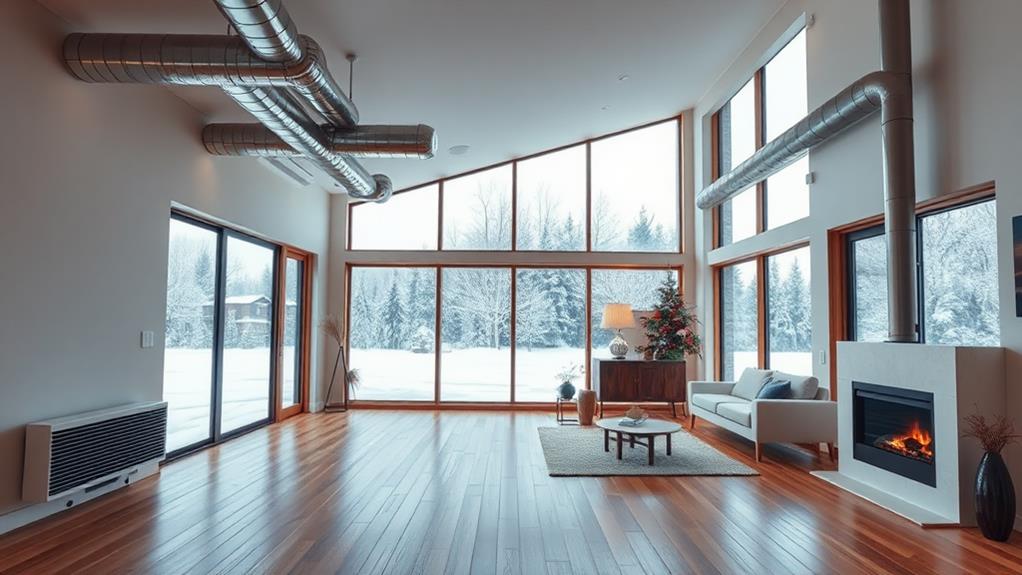Installing solar panels on our home's roof provides substantial financial benefits, including annual savings on energy bills ranging from $1,200 to $1,800, while simultaneously increasing property value by approximately 4.1% or about $15,000. Additionally, homeowners can take advantage of a 30% federal tax credit, which enhances the overall return on investment and shortens payback periods to 5 to 7 years. Environmental advantages also arise, as each panel offsets about 1 ton of CO2 yearly, contributing to improved air quality and sustainability. By incorporating this technology, we support job creation in the solar industry, which has seen significant growth recently, as we explore more advantages.
Key Takeaways
- Solar panels significantly lower energy bills, saving homeowners $1,200 to $1,800 annually while locking in electricity costs.
- Installing solar systems increases property value by an average of 4.1%, attracting energy-conscious buyers.
- Homeowners can benefit from a 30% federal tax credit, along with potential state-specific incentives, reducing installation costs.
- Solar panels contribute to environmental sustainability by offsetting CO2 emissions and promoting renewable energy reliance.
- The solar industry generates diverse job opportunities, contributing to economic growth and employment in local communities.
Lower Energy Bills
When we think about lowering energy bills, installing solar panels on our roofs stands out as a smart choice. By harnessing solar power, we can markedly reduce our utility bills, often saving between $100 to $150 each month. This translates to impressive annual savings of $1,200 to $1,800, which can provide us with more financial flexibility. As utility rates are projected to rise, going solar effectively locks in our electricity costs, protecting us from future increases. Additionally, net metering allows us to earn credits for any excess energy our systems generate, further enhancing our energy savings. Ultimately, investing in solar panels not only helps us save money now but also secures a more sustainable financial future for our households.
Increased Property Value
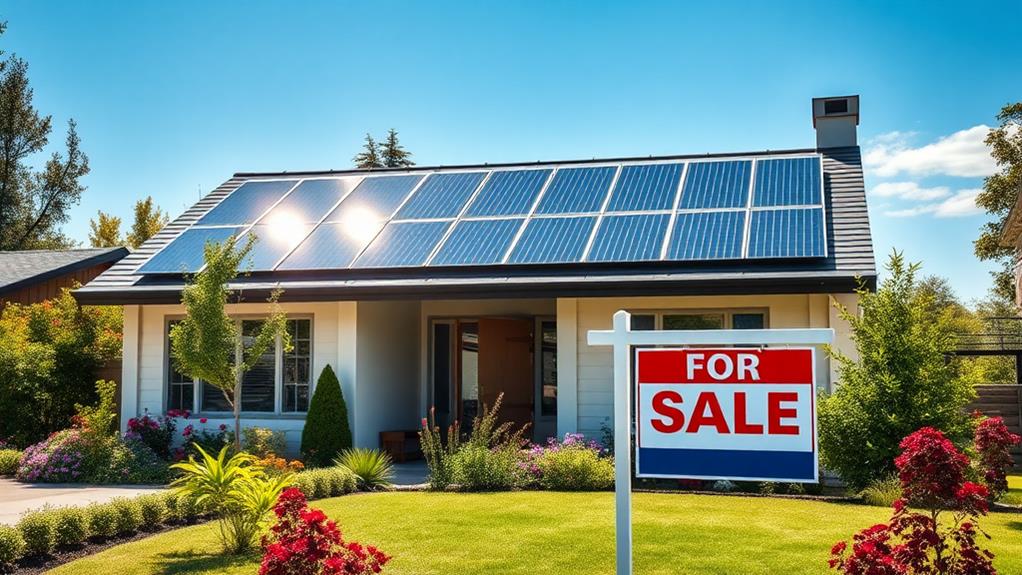
When we consider the financial benefits of installing solar panels, it's crucial to recognize their potential to greatly enhance property value. Research shows that homes equipped with solar energy systems can sell for an average of 4.1% more than those without, appealing particularly to the 67% of homebuyers who prioritize energy efficiency. Furthermore, the ability to transfer solar loans not only increases the attractiveness of the property but also positions us well in a competitive housing market, potentially adding approximately $15,000 to the overall value of our home.
Homebuyer Energy Efficiency Preference
Many homebuyers today are increasingly focused on energy efficiency, which considerably influences property values. A significant 67% of homebuyers prioritize energy-saving features, such as solar panels, when evaluating potential homes. Research by Zillow shows that homes with solar installations sell for an average of 4.1% more than those without, highlighting their impact on market value. Additionally, solar loans are transferable to new homeowners, enhancing the appeal of properties equipped with renewable energy systems. As society shifts towards sustainability, homes featuring solar energy systems not only embody modernity but also align with eco-conscious values. This growing demand for energy-efficient homes confirms that investing in solar panels is a strategic way to elevate your property's desirability and market position.
Premium Sale Price Increase
Investing in solar panels can considerably boost a home's market value, making it an appealing option for homeowners looking to sell. Research indicates that homes equipped with solar energy systems can command a premium sale price increase of approximately 4.1% compared to similar properties without solar installations. This increase in home value, estimated to be around $15,000 on average, reflects the growing demand for energy-efficient homes among potential buyers. Additionally, the transferability of solar loans to new homeowners further enhances the attractiveness of solar installations, as buyers recognize these systems as valuable upgrades. Ultimately, integrating solar panels not only contributes to sustainability but also markedly elevates a property's market appeal and financial return.
Environmental Impact
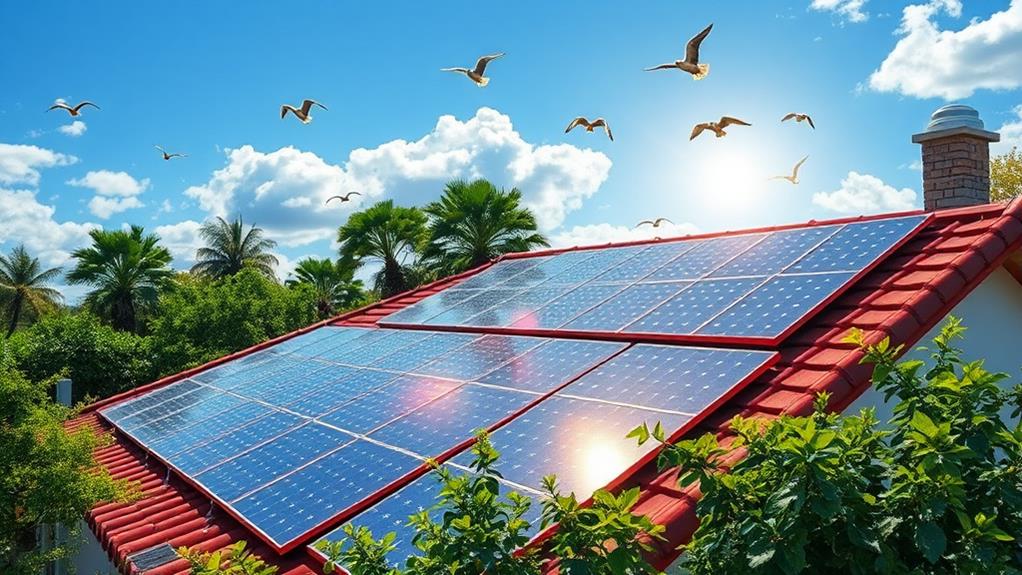
Solar panels offer a powerful way to make a positive environmental impact. By installing a solar energy system, we can greatly reduce carbon emissions, with each panel offsetting about 1 ton of CO2 annually. This change helps us rely less on fossil fuels, promoting renewable energy sources essential for combating climate change.
| Benefit | Impact |
|---|---|
| Carbon Emissions Reduction | Up to 3 tons less per installation |
| Improved Air Quality | No harmful pollutants emitted |
| Lower Greenhouse Gas Emissions | Supports environmental sustainability |
| Community Resilience | Enhanced local adaptation |
| Public Health Benefits | Cleaner air, healthier communities |
Financial Incentives
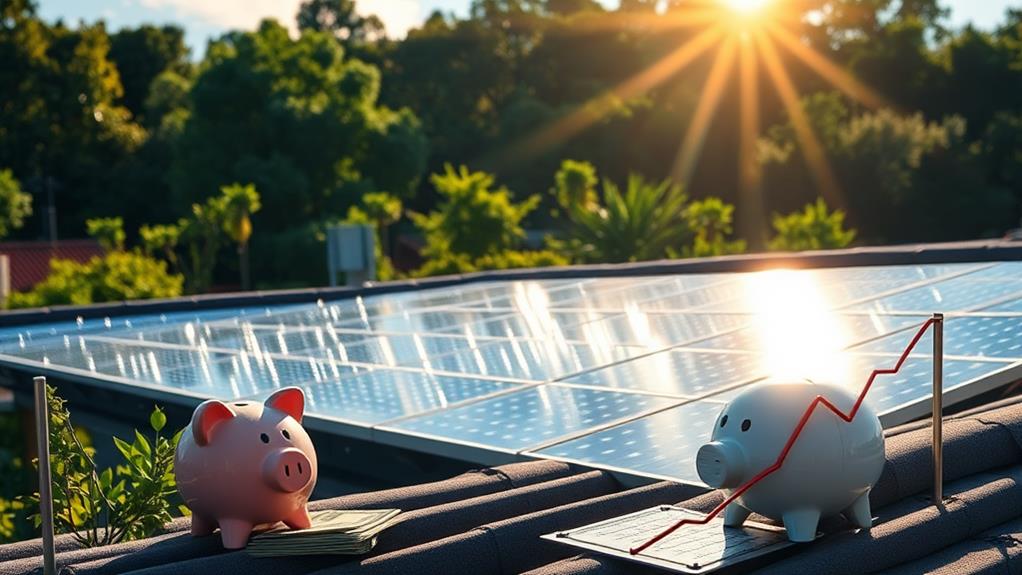
When we consider the financial incentives associated with installing solar panels, it's crucial to recognize the substantial benefits of the 30% federal solar tax credit, which is set to decrease to 26% after January 1, 2033. Additionally, various state-specific incentive programs can further lower our installation costs, making solar energy increasingly accessible and appealing. By leveraging these incentives, we can greatly shorten our payback period, often realizing savings within a mere 5 to 7 years.
Federal Tax Credit Benefits
One of the most compelling reasons to contemplate solar panels for our homes is the significant federal tax credit that can help offset installation costs. The federal residential solar tax credit allows us to deduct 30% of the installation costs from our federal taxes, substantially easing the financial burden of shifting to solar energy. Importantly, this tax credit applies to both purchased and financed solar systems, broadening accessibility. Homeowners who install solar panels by January 1, 2033, can take advantage of the full 30% credit, which will decrease to 26% thereafter. By applying this solar tax credit to the total cost, including equipment and installation, we maximize potential savings and shorten the payback period, allowing us to benefit from reduced utility bills sooner.
State-Specific Incentive Programs
Investing in solar energy doesn't just stop with federal tax credits; state-specific incentive programs can provide us with substantial financial benefits as well. Many states offer additional financial incentives that can greatly reduce the overall cost of solar installations for homeowners. These incentives can include:
- Rebates: Direct cash incentives for installing solar energy systems.
- Grants: Financial assistance programs to lower upfront costs.
- Tax Exemptions: Reductions on property taxes related to solar installations.
- Performance-Based Incentives: Payments based on the actual energy produced by solar energy systems.
Programs like California's Self-Generation Incentive Program and New York's NY-Solar Incentive can shorten the breakeven time for homeowners, making solar energy more accessible and financially viable.
Job Creation

In recent years, the solar industry has emerged as a powerhouse for job creation, employing over 250,000 individuals across the United States as of 2022. This sector offers diverse job opportunities, spanning fields such as solar panel installation, manufacturing, sales, research, and development, contributing to a robust workforce. Remarkably, solar job growth has greatly outpaced the overall job growth rate, with employment increasing by 167% from 2010 to 2020. Additionally, investment in solar technology stimulates local economies, as every megawatt of solar power installed generates approximately 5.65 full-time jobs. As advancements in solar technology continue and adoption increases, we can expect more job creation, reinforcing the U.S. position as a leader in renewable energy innovation.
Low Maintenance Needs
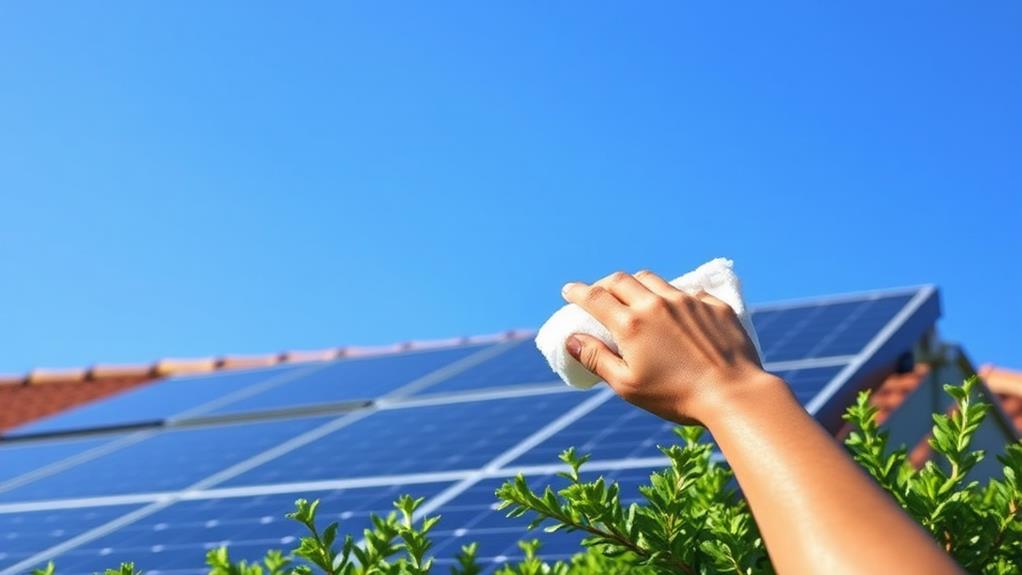
Solar panels are remarkably low-maintenance, making them an attractive option for homeowners. Their durability and efficiency guarantee they stand the test of time, with minimal upkeep required. Here's what we can expect regarding their low maintenance needs:
- No Moving Parts: The absence of mechanical components greatly reduces failure rates.
- Periodic Cleaning: A simple task of removing dust and debris, which can be done by us or hired professionals.
- Self-Cleaning Technology: Many systems incorporate features that further cut down on routine maintenance.
- Cost-Effective Energy Solution: Compared to other energy sources, solar panels maintain high efficiency with lower maintenance requirements, solidifying their appeal as a long-term investment.
Enhanced Efficiency
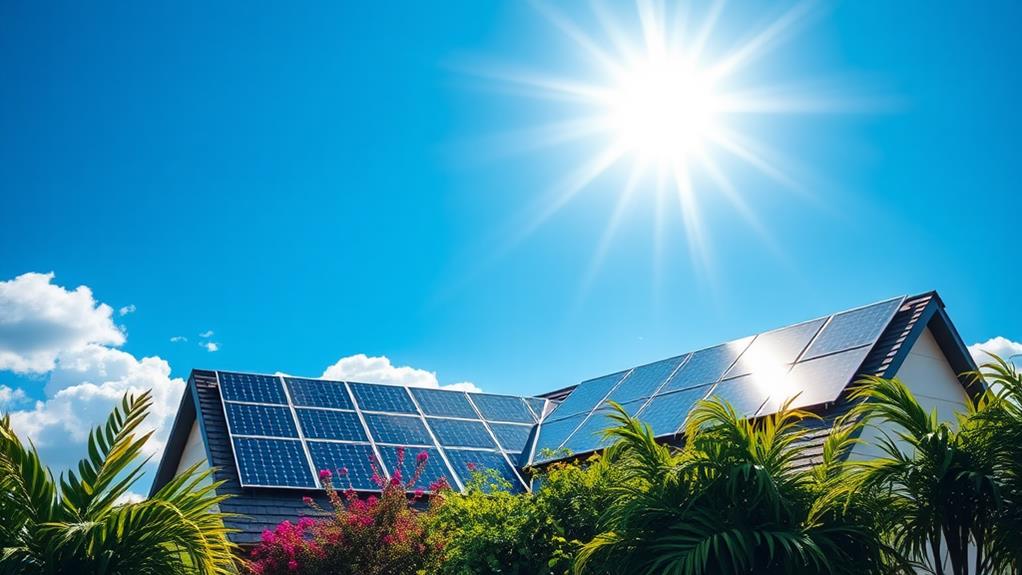
The enhanced efficiency of modern solar panels has transformed them into a smart choice for homeowners looking to maximize their energy production. Recent advancements have pushed efficiency rates beyond 20%, enabling us to generate more energy from the same sunlight. The latest photovoltaic (PV) cells capture a broader spectrum of sunlight, greatly boosting energy generation. Additionally, innovative manufacturing processes guarantee our solar panels are durable and can withstand harsh weather. Coupled with advancements in battery storage, we can refine our energy usage throughout the day. Importantly, solar panels maintain their efficiency with minimal upkeep, requiring only occasional cleaning for peak energy production.
| Aspect | Benefit | Importance |
|---|---|---|
| Efficiency Rate | Over 20% | Maximizes energy generation |
| Photovoltaic Technology | Broader sunlight spectrum | Increases overall output |
| Battery Storage Innovations | Flexible energy usage | Enhances consumption refinement |
Climate Adaptability

Many homeowners might be surprised to learn that solar panels excel in a variety of climates, including regions with harsh winters. Their climate adaptability is a crucial feature that enhances their appeal. Consider these points:
- Solar panels can generate electricity even in cold, snowy conditions.
- The U.S. Department of Energy's Solar Energy Technologies Office has guaranteed their durability across diverse weather conditions.
- Enhanced photovoltaic (PV) technology allows for efficient energy capture, maximizing performance regardless of temperature.
- Regional Test Centers confirm solar panels maintain energy efficiency in various geographic locations.
Ultimately, as we embrace renewable energy, we can take comfort in knowing that solar panels thrive in different sunlight conditions, proving their reliability and effectiveness in our homes.
Frequently Asked Questions
Is Putting Solar Panels on Your Roof a Good Idea?
Is putting solar panels on our roof a good idea? Absolutely! We'll enjoy significant energy savings, boost home value, benefit from government incentives, and face minimal maintenance—all while positively impacting the environment and enhancing our home's aesthetics.
Why Do Some People Put Solar Panels on the Roof of Their Home?
Many of us choose solar panels for energy independence, reducing installation costs through government incentives. We appreciate the positive environmental impact, increased property value, and low maintenance requirements, all while enhancing our home's aesthetic appeal.
Why Should I Put Solar Panels on My House?
So, why not embrace the future like we're living in the Jetsons? We'll enjoy cost savings and increased home value, benefit the environment, gain energy independence, and take advantage of government incentives with easy maintenance after installation.
What Is the Downside of Solar Panels on a House?
When considering solar panels, we should be aware of installation challenges, initial costs, aesthetic concerns, and maintenance requirements. Additionally, roof compatibility and potential impact on resale value can affect our decision about energy efficiency.

